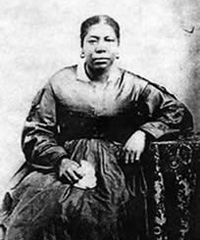
Early Mormonism had a range of doctrines related to race with regards to Black people of African descent. References to Black people, their social condition during the 19th and 20th centuries, and their spiritual place in Western Christianity as well as in Mormon scripture were complicated.
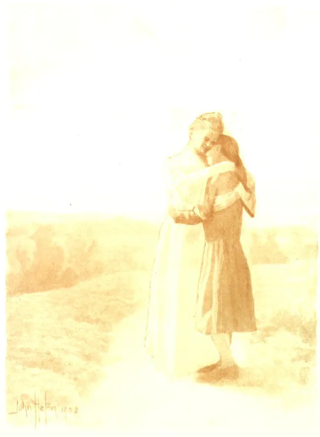
In the Latter Day Saint movement, Heavenly Mother, also known as Mother in Heaven, is the mother of human spirits and the wife of God the Father. Collectively Heavenly Mother and Father are called Heavenly Parents. Those who accept the Mother in Heaven doctrine trace its origins to Joseph Smith, founder of the Latter Day Saint movement. The doctrine became more widely known after Smith's death in 1844.

In orthodox Mormonism, the term God generally refers to the biblical God the Father, whom Latter Day Saints also refer to as Elohim or Heavenly Father, while the term Godhead refers to a council of three distinct divine persons consisting of God the Father, Jesus Christ, and the Holy Ghost. However, in Latter Day Saint theology the term God may also refer to, in some contexts, the Godhead as a whole or to each member individually.
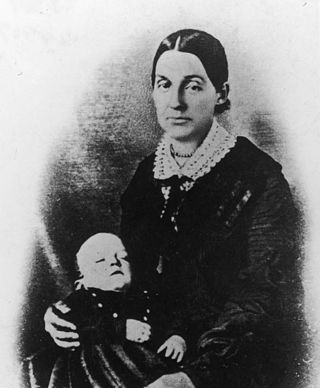
Emma Hale Smith Bidamon was a leader in the early Latter Day Saint movement and a prominent member of the Reorganized Church of Jesus Christ of Latter Day Saints as well as the first wife of Joseph Smith, the movement's founder. In 1842, when the Ladies' Relief Society of Nauvoo was formed as a women's service organization, she was elected by its members as the organization's first president.

Kolob is a star or planet described in the Book of Abraham, a sacred text of the Latter Day Saint movement. Several Latter Day Saint denominations claim that the Book of Abraham was translated from an Egyptian papyrus scroll by Joseph Smith, the founder of the movement. According to this work, Kolob is the heavenly body nearest to the throne of God. While the Book of Abraham calls Kolob a "star", it also calls planets "stars", and therefore some Latter Day Saint commentators consider Kolob a planet. The body also appears in Latter Day Saint culture, including a reference to Kolob in an LDS hymn.
"The Spirit of God Like a Fire Is Burning" is a hymn of the Latter Day Saint movement. It was written by W. W. Phelps, one of the most prolific hymnwriters of early Latter Day Saint movement.

The succession crisis in the Latter Day Saint movement occurred after the killing of the movement's founder, Joseph Smith, on June 27, 1844.

William Wines Phelps was an American author, composer, politician, and early leader of the Latter Day Saint movement. He printed the first edition of the Book of Commandments that became a standard work of the church and wrote numerous hymns, some of which are included in the current version of the Church of Jesus Christ of Latter-day Saints' hymnal. He was at times both close to and at odds with church leadership. He testified against Joseph Smith, providing evidence that helped persuade authorities to arrest Smith. He was excommunicated three times and rejoined the church each time. He was a ghostwriter for Smith. Phelps was called by Smith to serve as assistant president of the church in Missouri and as a member of the Council of Fifty. After Smith's death, Phelps supported Brigham Young, who was the church's new president.
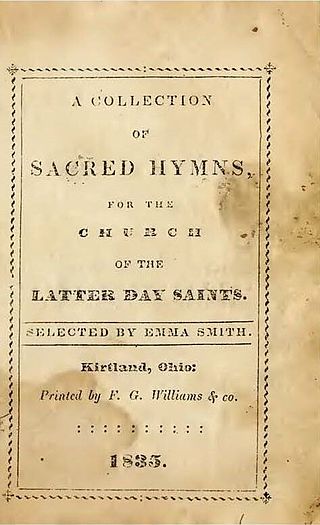
A Collection of Sacred Hymns, for the Church of the Latter Day Saints. was the first hymnal of the Latter Day Saint movement. It was published in 1835 by the Church of the Latter Day Saints.
"Adam-ondi-Ahman" is an LDS hymn and was included in the first Latter Day Saint hymnal and quickly became one of the most popular songs of the early church. It was published in 1835 in Messenger and Advocate and is hymn number 49 in the current LDS Church hymnal.
Hymns are an important part of the history and worship of the Church of Jesus Christ of Latter-day Saints.
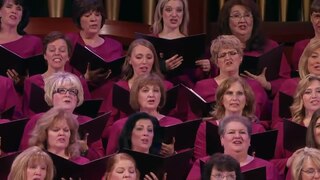
"We Thank Thee, O God, for a Prophet" is a hymn of the Church of Jesus Christ of Latter-day Saints. It has been sung at many general conferences of the LDS Church since it was published in 1863.
The Good Neighbor policy is the 1927 reform of the Church of Jesus Christ of Latter-day Saints that removed any suggestion in church literature, sermons, and ordinances that its members should seek vengeance on US citizens or governments, particularly for the assassinations of its founder Joseph Smith and his brother, Hyrum.
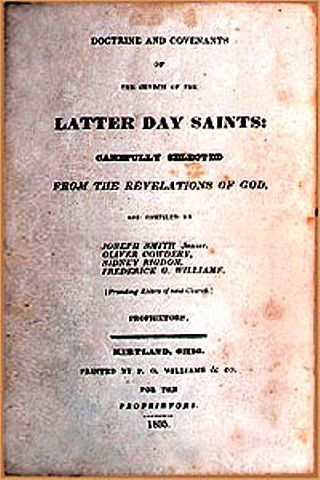
The One Mighty and Strong is the subject of an 1832 prophecy by Joseph Smith, the founder of the Latter Day Saint movement. The prophecy echoes and parallels the words and prophecies contained in Isaiah 28:2 and Isaiah 11:11; 2 Nephi 3:21-25. The One Mighty and Strong was said by Smith to be one who would "set in order the house of God" and arrange for the "inheritances of the [Latter Day] Saints." Since the prophecy was proclaimed, many Latter Day Saints have claimed to be or to have otherwise identified the One Mighty and Strong. Some schismatic Latter Day Saint sects have arisen as a result of such claims.
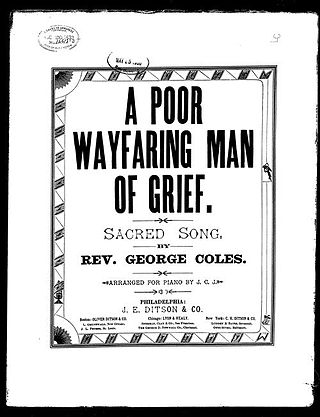
"A Poor Wayfaring Man of Grief" is a seven-stanza poem written in 1826 by James Montgomery. The words of the poem have since been adopted as a Christian hymn.
"How Firm a Foundation" is a Christian hymn, published in 1787 by John Rippon in A Selection of Hymns from the Best Authors, Intended to be an Appendix to Dr. Watts's Psalms and Hymns, known as "Rippon's Selection." How Firm a Foundation is number 128 in the 1787 first printing. It is attributed only to "K", which probably refers to Robert Keen(e), precentor at Rippon's church, though other names suggested include Richard or John Keene, Kirkham, John Keith or Words by G. Keith and Music by J. Reading as cited in the 1884 publication of Asa Hull's Jewels of Praise. It is most often sung to the tune "Foundation" which first appeared in A Compilation of Genuine Church Music (1832) edited by Joseph Funk, though the original tune may be Keen(e)'s "Geard".
"The Morning Breaks, the Shadows Flee" is an 1840 hymn written by Latter Day Saint apostle Parley P. Pratt.
Heavenly Parents is the term used in Mormonism to refer collectively to the divine partnership of God the Father and the Heavenly Mother who are believed to be parents of human spirits. The concept traces its origins to Joseph Smith, the founder of the Latter Day Saint movement.
In Nauvoo, Illinois, in 1841, Emma Smith published an expanded version of the 1835 Collection of Sacred Hymns . The new hymnal contained 304 hymns, in words-only format. Of these, 77 hymns had been included in the 1835 hymnbook. Many of the hymns included in the 1841 hymnal were more focused on grace, the blood of Christ, and the cross than other LDS hymn collections. Examples include "Amazing Grace", "Come, Thou Fount of Every Blessing", and "When I Survey the Wondrous Cross". After the succession crisis in the early Latter Day Saint movement following Joseph Smith's death, this hymnal was largely ignored in favor of the Manchester Hymnal by those church members who followed the Quorum of the Twelve and moved to the Salt Lake Valley. In the Reorganized Church of Jesus Christ of Latter Day Saints, however, the opposite was true.












